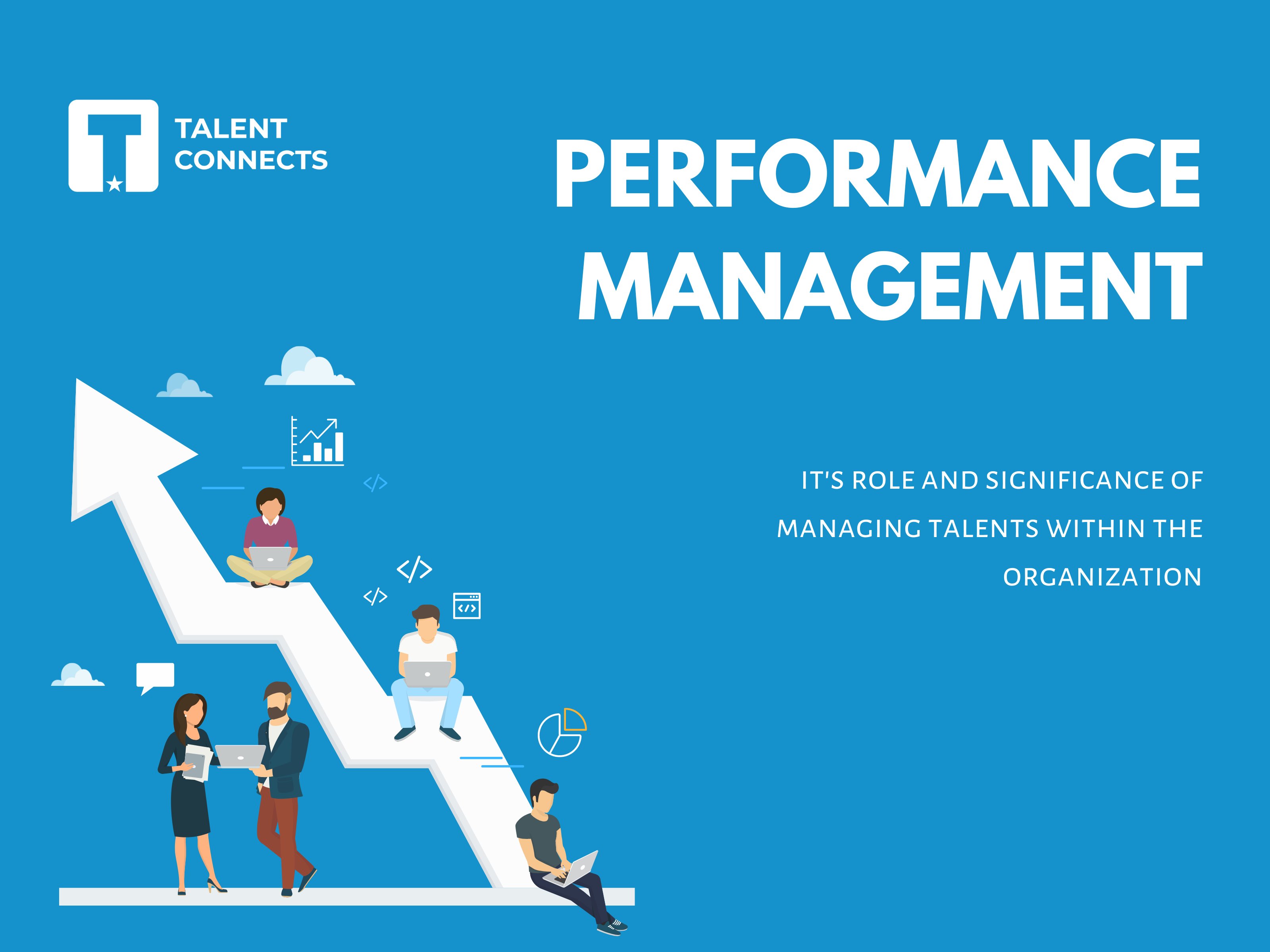Performance Management - Its Role and Significance of Managing Talent within the Organization
Performance management is a management tool in a corporate environment that helps managers evaluate and monitor the work of the employees. The main objective of performance management is to evaluate the work progress of the workers along with optimizing their efficiency and ability for the productivity of the business.
Performance management brings together two elements in a firm: Individual work and organizational goals. They align the individual efforts with respect to the mission and objectives of the firm.
Other universal elements of performance management are:
Developing specific job-performance outcomes: wherein the employees are aware of their actions having an impact on the firm’s profit. They are accountable for their actions hence perform tasks efficiently.
Creating measurable performance-based expectations: Employers should make the work standards clear for the expectations to be fulfilled otherwise there may be some defaulters regarding the same.
Defining job-development plans: There should be high degree of creativity from the side of employees as well as employers, frequent meetings amongst the supervisors and employees would lead to definition of job duties.
The Performance Management Cycle
It is a systematic strategy used by organizations to successfully manage and enhance employee performance. It usually consists of a set of phases or stages that are repeated on a regular basis.
Planning: This step comprises creating goals for employees and conveying those goals to them. While these objectives should be included in the job description to attract qualified candidates, they should be reiterated after the individual is hired. It entails defining performance expectations, determining the resources required, and establishing performance criteria.
Monitoring: Managers must monitor employees' progress towards the goal throughout this period. This is where continuous performance management steps in. You can track your team's performance in real time and change and correct course as needed with the proper performance management software. Regular check-ins, progress evaluations, and feedback sessions may be required.
Developing: This phase entails using the data gathered during the monitoring phase to enhance employee performance. To boost performance or sustain excellence, it may be necessary to offer refresher courses, provide an assignment that helps them improve their knowledge and performance on the job, or change the direction of employee growth. Initiatives for training, mentorship, and development may be implemented.
Rating: Each employee's performance must be evaluated on a regular basis, as well as at the time of the performance evaluation. Ratings are critical for determining the level of employee performance and implementing appropriate improvements. These ratings can be provided by both peers and management.
Rewarding: Recognizing and rewarding excellent performance is critical to the performance management process and an important component of employee engagement. Rewards can be monetary incentives, promotions, or non-monetary recognition.
Techniques involved in performance management
Graphical rating: This form of rating is done on a check box format, from a scale of 1-5 on the basis of how well a selected task is performed by the employee. However such form of rating is affected by personal factors and biasedness. It also leads to development of a particular employee in a selected field.
360-Degree Feedback: 360-degree feedback entails obtaining input from a variety of sources, such as supervisors, peers, subordinates, and, in some cases, consumers or clients. This feedback gives a thorough assessment of an individual's strengths and opportunities for development, assisting in the enhancement of self-awareness and the formulation of performance improvement strategies.
Balanced scorecard: The balanced scorecard is a strategic performance management tool that assesses success across various aspects other than financial metrics. It usually covers four points of view: financial, customer, internal processes, and learning and growth. This strategy offers a comprehensive perspective of performance and enables a balanced approach to goal attainment.
Peer feedback and self-assessment: Employees offering input on one other's work or reflecting on their own performance are examples of peer feedback and self-assessment strategies. This method stimulates self-reflection, cooperation, and gives a broader view on performance strengths and opportunities for growth. However it is not a reliable method since some employees during peer evaluation may project their personal grudges whereas in self-assessment some may undermine themselves while others may overestimate their capabilities.
KPI and KRA are two essential quantifiable values that assist company owners/HR professionals assess their performance and development when it comes to monitoring success. KRA is for Key Result Area, which is also known as the Key Responsibility Area, while KPI stands for Key Performance Indicators.
KPI: KPIs are quantifiable indicators that are used to analyze and measure a company's or workers' progress. KPIs for different firms and organizations can change and be distinct depending on the business objectives.
KRA: Key Responsibility Areas, are measurable duties and obligations assigned to individuals in a company. Within the same firm, various workers may have varying KRAs based on their job profile, experience, and expectations.
Performance management in Nepal
Based on our primary research, which involved conducting on-call interviews with three multinational IT companies and three local IT companies, we obtained valuable data regarding their performance appraisal processes. The information collected from the local IT companies revealed that performance appraisals are typically carried out once a year, often towards the end of the fiscal year, or on a quarterly basis. On the other hand, the appraisal process in multinational IT companies is conducted more frequently, specifically on a monthly and regular basis. The purpose of this appraisal is to assess the growth and development of employees, determine appropriate pay rates, and evaluate their competency.
The most commonly employed mechanism for performance management by companies in Nepal is quarterly goal setting, HRIS and KPI’s with only a few companies implementing the practice of 360-degree feedback. In companies where 360-degree feedback is utilized, there is a minimal occurrence of bias since the feedback is provided by line managers. In instances where employees suspect bias during the performance appraisal, they are shown evidence of their performance to address any concerns or doubts. Additionally, some companies provide employees with Key Performance Indicators (KPI) and Key Result Areas (KRA) to facilitate goal setting. The performance levels are often categorized into five tiers: 5 being Outstanding, 4 stating Exceeds Expectations, 3 stating Meets Expectations, 2 stating Needs Improvement and 1 stating Unacceptable. To eliminate biasness the KPI goal settings are mutually agreed upon in the beginning phase itself.
There are also procedures wherein onboarding managers are given orientations and trainings regarding the policies and procedures of performance evaluation process.
Data related to performance appraisal, is typically stored in digital formats such as Google Spreadsheets or HRIS (Human Resources Information System) stores, eliminating the need for physical copies. Access to these documents is limited to the relevant systematic teams or departments. The techniques and practices of performance appraisal are updated annually to align with the needs of new employees, and new features are introduced as necessary.
Following the completion of the performance appraisal process, there are departmental or one-on-one discussions held to communicate the results and provide feedback to individuals. But this is not implemented in all the companies, only a few companies provide instant feedbacks. Employees have the opportunity to view their scores on the rating scale. In the event of any disputes or conflicts, the HR team intervenes and arranges one-on-one meetings with the individuals involved to address the issues.
In practice, it has been discovered that there is a considerable link between employee performance inspection and organizational performance. The evaluation of performance should be completed as regularly as feasible, the supervisor should collaborate with the subordinate to agree on tasks, and the supervisor should commit adequate time to track and evaluate an employee's performance. It would be beneficial to the development of self-awareness among employees, which would aid in the improvement of both employee and organizational performance.
Written by: Kavya Tulsyan | Christ University BGR Campus | BA. Economics Honors
(HR Internship assignment at Talent Connects)



